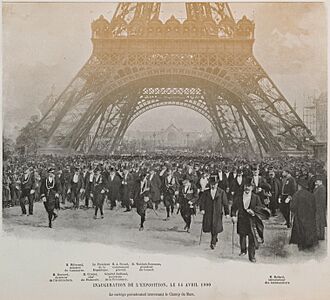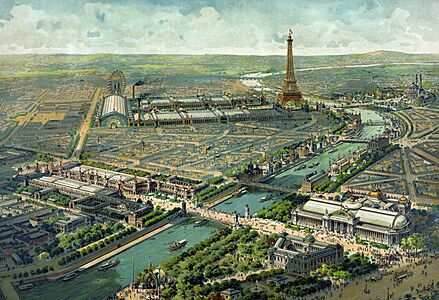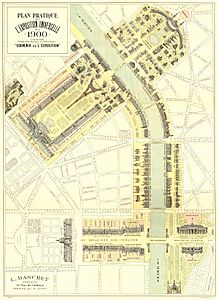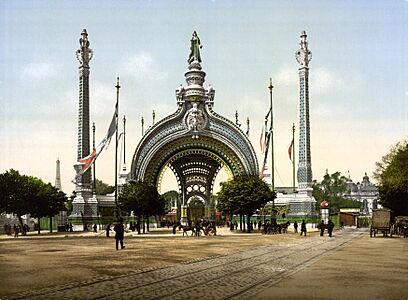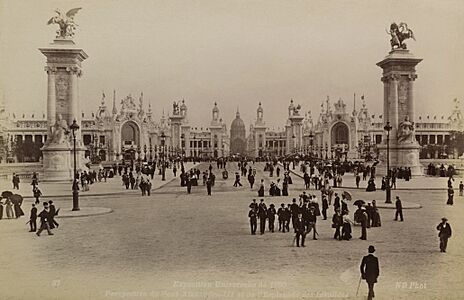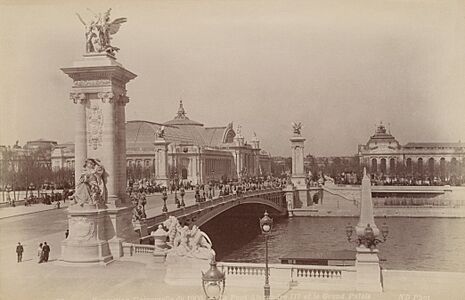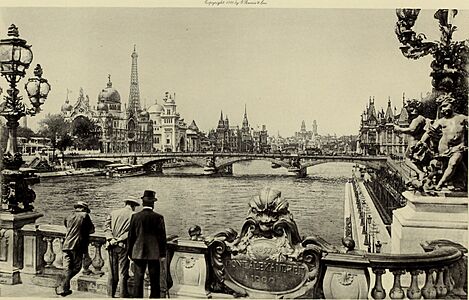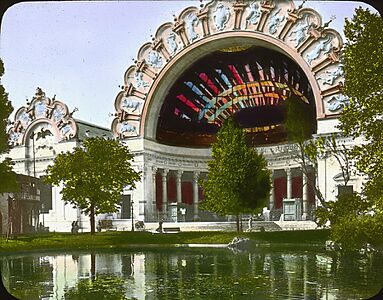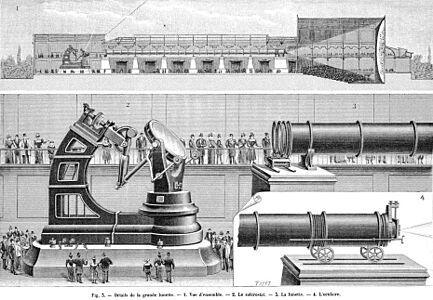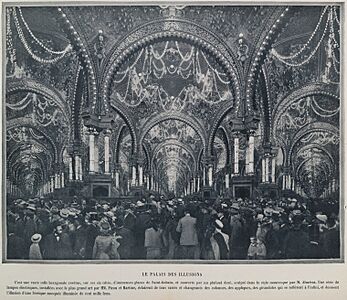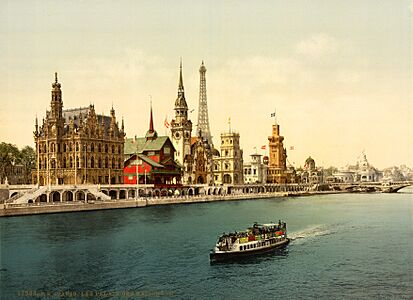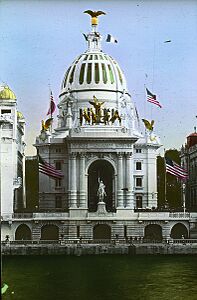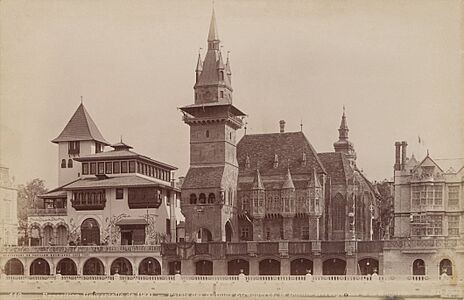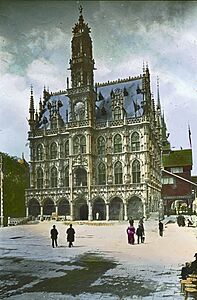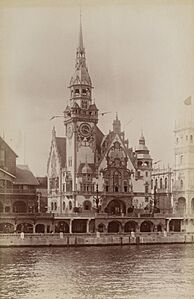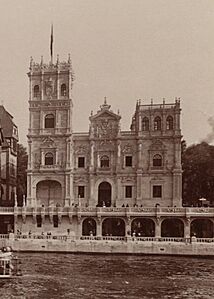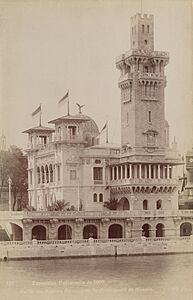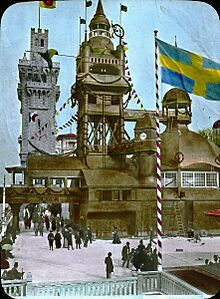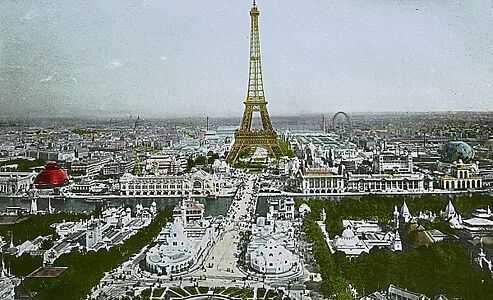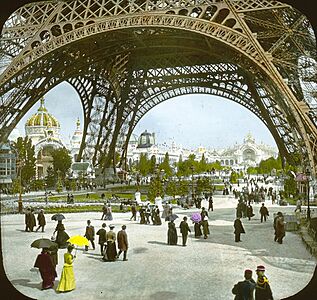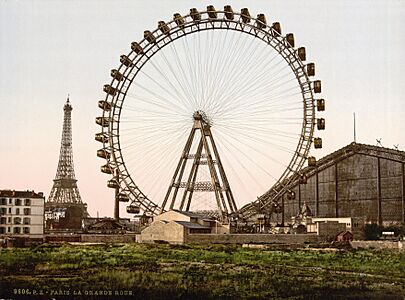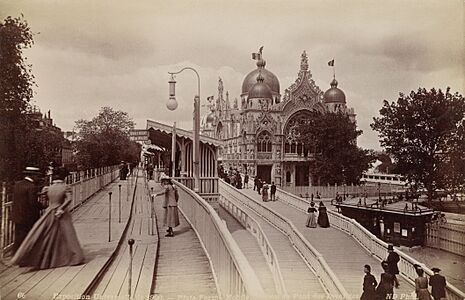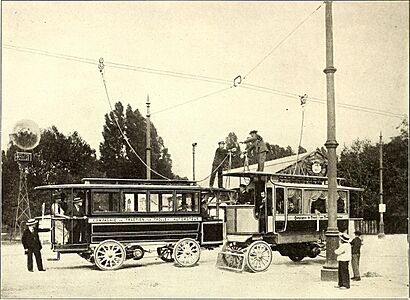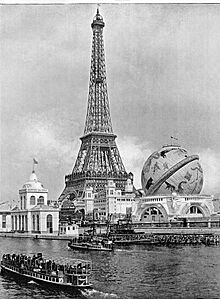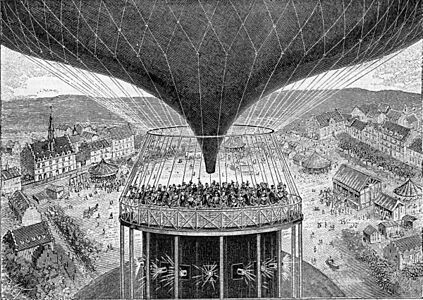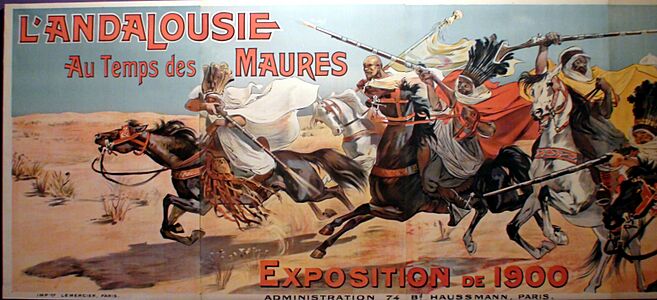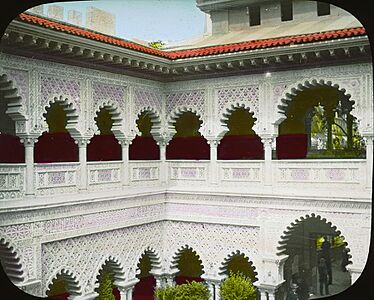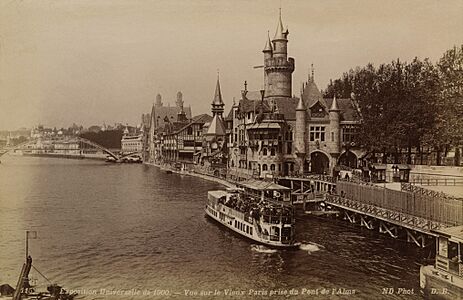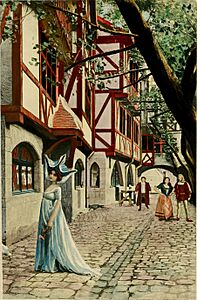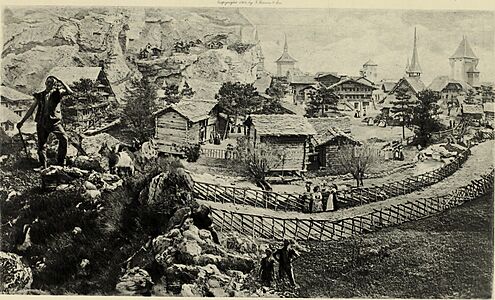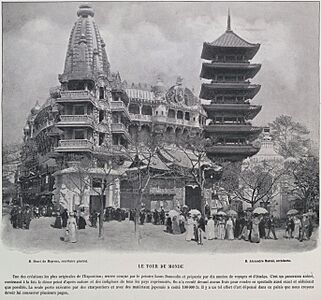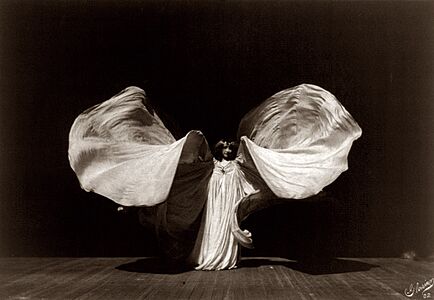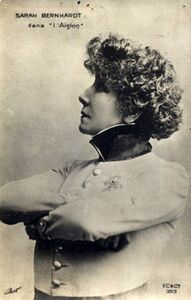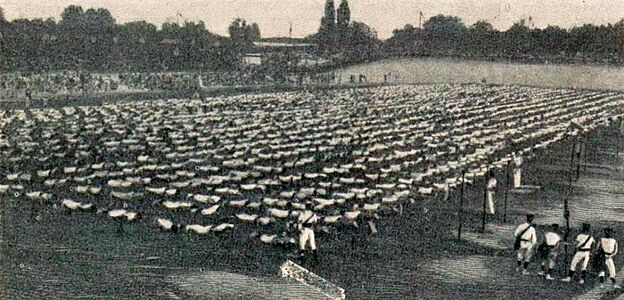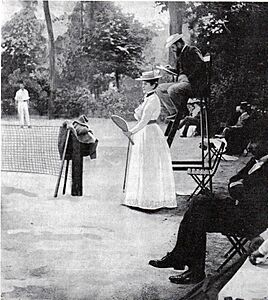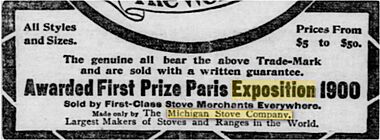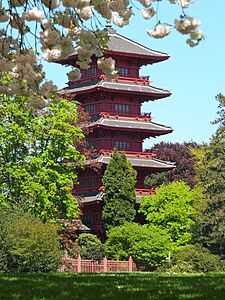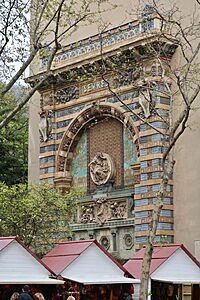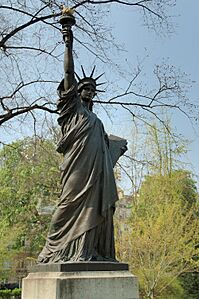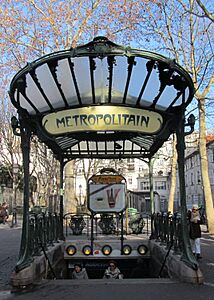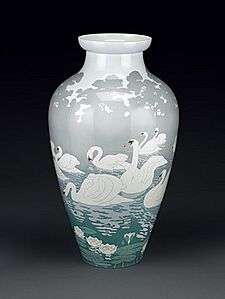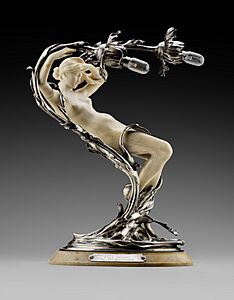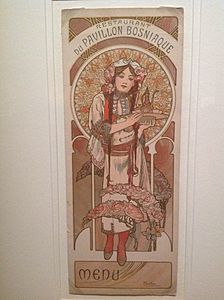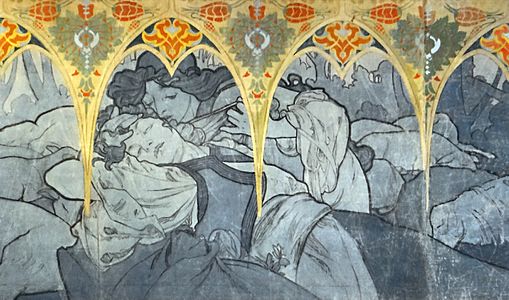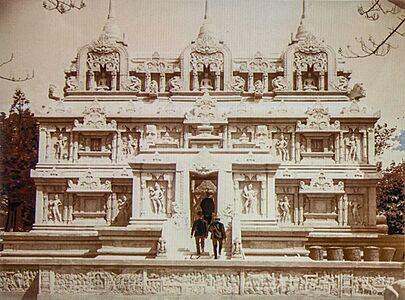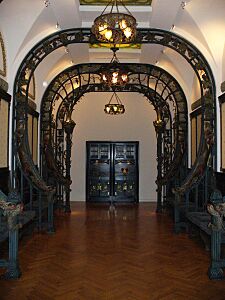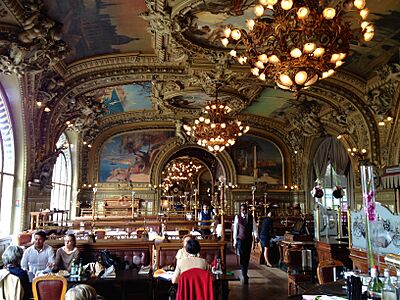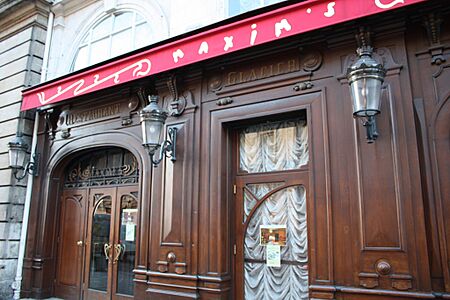Exposition Universelle (1900) facts for kids
Quick facts for kids 1900 Paris |
|
|---|---|

Poster
|
|
| Overview | |
| BIE-class | Universal exposition |
| Category | International Recognized Exhibition |
| Name | L'Exposition de Paris 1900 |
| Area | 216 hectares (530 acres) |
| Visitors | 48,130,300 |
| Participant(s) | |
| Business | 76,112 |
| Location | |
| Country | France |
| City | Paris |
| Venue | Esplanade des Invalides, Champ de Mars, Trocadéro, banks of the Seine and Bois de Vincennes |
| Timeline | |
| Opening | 14 April 1900 |
| Closure | 12 November 1900 |
| Universal expositions | |
| Previous | Brussels International (1897) in Brussels |
| Next | Louisiana Purchase Exposition in St. Louis |
The Exposition Universelle of 1900, also known as the 1900 Paris Exposition, was a huge world's fair held in Paris, France, from April 14 to November 12, 1900. It was a celebration of the amazing things achieved in the 19th century and a look forward to new developments in the 20th century. This was the sixth major world's fair held in Paris. It took place in several famous spots like Les Invalides, the Champ de Mars, the Trocadéro, and along the Seine River. More than 50 million people visited the fair! Many international meetings and events, including the 1900 Summer Olympics, were part of this big event.
The fair showed off many cool new technologies. These included the giant Grande Roue de Paris ferris wheel, the first ever Rue de l'Avenir moving sidewalk, and the first regular passenger trolleybus line. Visitors could also see escalators, diesel engines, electric cars, and talking films. The telegraphone, which was the first magnetic audio recorder, was also there. The fair also introduced the Art Nouveau style to a wider audience. France also used the fair to show off its power as a colonial nation with many pavilions from its colonies.
Some major buildings were constructed for the fair that you can still see today. These include the Grand Palais, the Petit Palais, the Pont Alexandre III bridge, and the Gare d'Orsay train station. The Paris Métro Line 1 also opened with its unique entrances designed by Hector Guimard.
Contents
Organizing the Paris Fair
World's Fairs started in London in 1851. The French Emperor Napoleon III was very impressed by it. He decided to have the first Paris Universal Exposition in 1855. These fairs were meant to show off French trade, technology, and culture. More fairs followed in 1867, 1878, and 1889. The 1889 fair celebrated 100 years since the French Revolution.
Planning for the 1900 Exposition started in 1892. Many leaders worked on it before it was finished. The fair officially opened on April 14, 1900, even though some buildings were not fully ready.
Countries at the Fair
France invited countries from all over the world to show their achievements and cultures. Out of 56 invited countries, 40 officially joined. Many colonies and protectorates from France, the Netherlands, Great Britain, and Portugal also took part.
| Participating nations | |||
|---|---|---|---|
|
|
Some regions like Finland and Egypt had their own pavilions but were officially part of larger empires. Countries without an official presence could still show their products in a joint "International Section."
Exploring the Fairgrounds
The fair covered a huge area of 112 hectares (280 acres) (about 277 acres) along the Seine River. It stretched from Les Invalides to the Eiffel Tower (which was built for the 1889 fair) at the Champ de Mars. It also included the Grand Palais and Petit Palais. An extra 104 hectares (260 acres) (about 257 acres) in the Bois de Vincennes was used for farming exhibits. The total area was ten times bigger than the 1855 fair!
Most buildings were temporary. They had iron frames covered with plaster and a material called staff, which was a cheap artificial stone. Many buildings weren't finished when the fair opened. Most were taken down right after the fair closed.
The Grand Entrance Gate
The Porte Monumentale de Paris was the main entrance to the fair. It was located at the Place de la Concorde. Architect René Binet designed it, taking inspiration from nature. It was decorated with colorful ceramic patterns and topped with a 6.5 metres (21 ft) (21-foot) tall statue called La Parisienne. This statue was unique because she wore modern Paris fashion. The gateway was lit up at night by 3,200 light bulbs and 40 arc lamps. About 40,000 visitors could pass through it every hour!
Like most fair buildings, this grand entrance was temporary and was taken down after the fair. Some parts of it, like the ceramic frieze showing the workers, were saved and can still be seen today in Breuillet, Essonne.
The Pont Alexandre III Bridge
The Pont Alexandre III bridge was a very important link at the fair. It connected the buildings on both sides of the Seine River. It was named after Czar Alexander III of Russia and celebrated the new friendship between France and Russia. His son, Czar Nicholas II, laid the first stone in 1896. The bridge was finished in 1900.
It was the widest and longest bridge in Paris at the time, built with a single steel arch 108 metres (354 ft) (354 feet) long. The bridge is decorated with statues of winged figures and gilded statues of the horse Pegasus. At its base, there are statues representing different periods of French history.
Cool Thematic Pavilions
The fair had huge pavilions for showing off industrial, commercial, scientific, and cultural exhibits. The Galerie des machines from the 1889 fair was reused. On the other side of the Seine, the Grand Palais and Petit Palais were built for art exhibitions.
Exhibitors were grouped into 18 main categories and then into 121 smaller classes. Each group had its own pavilion. Countries also had their own sections within these pavilions.
Palaces of Optics, Illusions, and Aquarium
Many pavilions focused on technology and science. The Palace of Optics was very popular. It had the Great Paris Exhibition Telescope of 1900, which could magnify the moon 10,000 times! The image was shown on a huge screen, 144 square metres (1,550 sq ft) (1,550 sq ft) in size, in a hall that seated 2,000 people. This was the largest refracting telescope of its time.
Another popular attraction was a giant kaleidoscope, which drew three million visitors. The Palace of Optics also showed X-rays and dancers in glowing costumes.
The Palais des Illusions (Palace of Illusions) was next to the Palace of Optics. It used mirrors and electric lights to create amazing optical illusions. It was so popular that it was saved after the fair and moved to the Musée Grévin.
The aquarium was another scientific wonder. It was the largest in the world at the time. Visitors could view it from an underground tunnel 722 metres (2,369 ft) (2,369 feet) long. The tanks were huge and held many exotic sea creatures.
Palace of Electricity and the Water Castle
The Palace of Electricity and the Water Castle were among the most popular sights. The Palace of Electricity was enormous, 420 metres (1,380 ft) (1,378 feet) long and 60 metres (200 ft) (197 feet) wide. Its shape looked like a giant peacock spreading its tail. The central tower had a huge glowing star and a statue of the Spirit of Electricity, 6.5 metres (21 ft) (21 feet) tall, holding a torch powered by 50,000 volts of electricity!
Electricity was used a lot to keep the fair open at night. The Palace and Water Castle were lit by 7,200 light bulbs and 17 arc lamps. Visitors could go inside to see the generators that powered the fair.
The Water Castle, facing the Palace of Electricity, was also very impressive. It had two large domes and a giant fountain that circulated 100,000 litres (22,000 imp gal; 26,000 US gal) (26,417 gallons) of water per minute. At night, the fountain was lit by constantly changing colored lights, thanks to the power from the Palace of Electricity.
The Grand Palais and Petit Palais
The Grand Palais (Big Palace) was built on the site of an older palace. It was meant for fine arts and decorative arts. Its iron frame was very modern for the time, using 9,000 tonnes (8,900 long tons; 9,900 short tons) (9,921 tons) of metal, more than the Eiffel Tower! The outside looked grand and traditional, but the inside had modern ironwork and stairways with Art Nouveau designs, featuring flowing, natural shapes. During the fair, it showed paintings and sculptures from France and other countries.
The Petit Palais (Small Palace) faces the Grand Palais. It was designed by Charles Girault. Its outside also looks traditional, like old French palaces. But inside, you can see more Art Nouveau details in the railings, floor tiles, stained glass, and ceiling murals. During the fair, it displayed French art from earlier centuries.
National Pavilions
Many countries built their own pavilions along the Seine River, on a street called the Rue des Nations (Street of Nations). Each country paid for its own pavilion. These buildings were temporary and often looked like famous landmarks from that country's history.
Some of the countries with pavilions on the Rue des Nations included Italy, Turkey, the United States, Austria, Great Britain, Germany, Spain, and Sweden. Other nations had pavilions elsewhere on the fairgrounds.
The Rue des Nations Pavilions
- The Turkish pavilion mixed Islamic architecture from Istanbul.
- The United States pavilion was a simpler version of the U.S. Capitol Building. The U.S. also had an important exhibit called The Exhibit of American Negroes. This exhibit showed the progress of African Americans, including patents, photos, and art.
- Bosnia and Herzegovina showed off their traditional lifestyles and embroidery.
- Hungary's pavilion displayed farming products and hunting gear.
- The British Royal pavilion was a mock-Jacobean mansion used for important guests.
- The German pavilion was the tallest at 76 metres (249 ft) (249 feet). Germany also had big displays of its technology and machinery.
- Spain's Royal Pavilion showed a collection of old Spanish tapestries. It also had the first restaurant in history with a fully electric kitchen!
- Sweden's bright yellow and red building stood out.
- Serbia's pavilion looked like a church and displayed Serbian products like wine and fabrics.
- Finland's pavilion had a clean, modern design.
Other National Pavilions
- Russia had an impressive pavilion on the Trocadéro hill. It looked like the towers of the Kremlin and showed art from Central Asia.
- The Chinese pavilion was shaped like a Buddhist temple.
- The Korean pavilion displayed Korean goods, including the Jikji, the oldest book printed with movable metal type.
- Morocco had its pavilion near the Eiffel Tower.
Fun Attractions at the Fair
Besides the serious exhibits, the fair offered many exciting attractions and amusements!
Eiffel Tower
The Eiffel Tower, built for the 1889 fair, was the main attraction of the 1900 Exposition. It was repainted in shades of yellow-orange and had 7,000 electric lamps. The lifts were also updated.
The Grande Roue de Paris
The Grande Roue de Paris was a giant ferris wheel 110 metres (360 ft) (361 feet) high. It could carry 1,600 passengers in its 40 cars! Even though it cost a bit more than a worker's hourly wage, people often waited an hour to ride it.
Moving Sidewalks and Electric Trains
The Rue de l'Avenir (Street of the Future) was a very popular and helpful moving sidewalk. It ran along the edge of the fair, from Les Invalides to the Champ de Mars, with nine stations. Passengers could step onto a slow moving sidewalk, then onto a faster one. It was a great way to get around the huge fair!
An electric train followed the same route in the opposite direction. It ran at about 17 kilometres per hour (11 mph) (10.5 mph). There was also an experimental passenger electrobus line in the Bois de Vincennes. This was the first trolleybus in regular passenger service ever!
The Globe Céleste
The Globe Céleste was a huge globe-shaped planetarium that showed the night sky. The globe was 45 metres (148 ft) (148 feet) wide and painted with constellations. Inside, visitors sat in armchairs and watched stars and planets projected above them.
Sadly, part of an access ramp to the globe collapsed, killing nine people. This accident led to the first safety rules for using reinforced concrete in France.
Early Motion Pictures
The Lumière brothers, who invented the first public movie projections, showed their films on a giant screen, 21 metres (69 ft) (69 feet) by 16 metres (52 ft) (52 feet). Another new invention was the Phono-Cinema Theater, which showed early "talking pictures" where the film was matched with sound from phonographs.
The Cinéorama was even more amazing. It simulated a balloon trip! Ten projectors showed a landscape on a circular screen 93 metres (305 ft) (305 feet) around. Viewers sat in a basket, feeling like they were really flying.
The Mareorama simulated a ship voyage. Viewers stood on a ship deck, watching painted scenes of cities and seascapes pass by. Machines rocked the ship and fans blew wind to make it feel real!
World Live Recreations
The fair had many recreated villages and scenes from around the world:
- L'Andalousie au temps des Maures (Andalusia in the Time of the Moors) was a large Spanish-themed area with Moorish buildings and live performances.
- Le Vieux Paris (Old Paris) recreated old Paris streets from the Middle Ages to the 18th century, with performers in costumes.
- The Swiss Village was a recreation of a Swiss mountain village, with a waterfall and chalets.
- The Panorama du Tour du Monde was a journey around the world, showing scenes from Europe to Japan with moving paintings and people in traditional clothes.
Other recreations included bazaars from Algiers and Tunis, a Venetian canal with gondolas, a Russian village, and a Japanese tea house.
Theatres and Music Halls
The fair had several large theaters. The Palais des Fêtes had 15,000 seats and offered music, ballet, and historical shows. The Rue de Paris had many amusements, including music venues, a comedy theater, and the "Backwards House" where furniture was on the ceiling!
The famous actress Sarah Bernhardt had her own theater. She performed in a popular play called L'Aiglon, where she played the son of Napoleon Bonaparte. Her shows were always sold out.
The American dancer Loie Fuller also had her own theater. She performed a famous "Serpentine dance" with large silk scarves that made her look like she was enveloped in a cloud. Her performances were captured in early motion pictures.
-
The dancer Loie Fuller had her own theater in Paris during the 1900 Exposition.
-
Sarah Bernhardt as L'Aiglon, the son of Napoleon Bonaparte.
Special Events
Many international meetings and events happened in Paris during the fair. A large area in the Bois de Vincennes was used for sports, including many events of the 1900 Summer Olympics.
1900 Summer Olympics Games
The 1900 Summer Olympics were the second modern Olympic Games. They were held in Paris from May 14 to October 28, 1900, as part of the fair. The term "Olympic Games" wasn't widely used then; they were often called "International physical exercises and sports competition."
According to the International Olympic Committee, 997 athletes competed in 19 different sports. For the first time, women were allowed to compete! Some unique events were held only at these Olympics, like automobile and motorcycle racing, ballooning, cricket, and underwater swimming. France had the most athletes and won the most medals.
Banquet of Mayors
A huge banquet was held for 20,777 mayors from France and its colonies. It took place on September 22, 1900, in the Tuileries Gardens. The dinner was prepared in 11 kitchens and served to 606 tables!
Awards Ceremony
The fair gave out many awards to its 83,047 exhibitors. The awards ceremony was held on August 18, 1900. There were 3,156 grand prizes, 8,889 gold medals, and many silver, bronze, and honorable mentions. Many companies, like Campbell's Soup, added their Paris award to their product labels.
Costs and Legacy
An admission ticket to the fair cost one franc. This was about two hours of work for an average Parisian worker. Many attractions inside also charged extra fees.
Most of the buildings were taken down after the fair. They were built to be temporary. However, some important structures were saved:
- The Grand Palais and Petit Palais.
- The Pont Alexandre III bridge.
- Many of the Art Nouveau metro station entrances designed by Hector Guimard. Two original ones still exist at Porte Dauphine and Abbesses.
- A ceramic gateway from the Palace of National Manufacturers, now in Square Felix-Desruelles.
- A smaller copy of the Statue of Liberty by Frédéric Auguste Bartholdi, now in the Luxembourg Gardens.
One unique leftover is La Ruche (The Beehive). This building was made from pieces of different fair buildings bought at auctions. It became a home and studio for many famous young artists and writers, like Marc Chagall and Henri Matisse. It is now a historical monument.
-
A 2.87 metres (9 ft 5 in) copy of the Statue of Liberty by Bartholdi.
Art Nouveau at the Fair
The Art Nouveau ("New Art") style was very popular at the 1900 fair. This style is decorative and inspired by nature, with curving lines of plants and flowers. While many buildings had a traditional look, Art Nouveau details appeared inside. You could see it in the ironwork of the main entrance, the Grand Palais, and the Petit Palais.
Art Nouveau was especially popular in decorative arts pavilions. Jewelry and glass companies showed off their Art Nouveau creations. Many fair posters also used this style. The famous Art Nouveau artist Alfons Mucha designed posters and murals for the fair.
The most famous examples of Art Nouveau from the fair are the unique entrances of the Paris Métro stations, designed by Hector Guimard. The style also appeared in popular restaurants like Maxim's and Le Train Bleu. The fair helped spread the Art Nouveau style around the world.
-
Paris Métro station entrance at Abbesses designed by Hector Guimard.
-
Art Nouveau swan vase by the Sèvres Manufactory.
-
Menu by Alfons Mucha for the restaurant of the Bosnia and Herzegovina pavilion.
-
Bosnia and Herzegovina pavilion murals by Alfons Mucha (1900).
More to Explore
- Art Nouveau in Paris
- French Colonial Empire
- Paris in the Belle Époque
- Mexico at the 1900 Universal Exhibition in Paris
- Grande fresque de la gare de Lyon


